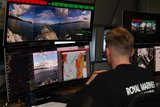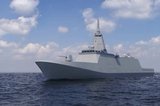Indian Navy commissions three Immediate Support Vessels
The Indian Navy commissioned the second batch of three Immediate Support Vessels (ISVs) in a ceremony at Naval Dockyard, Visakhapatnam on 24 March.
The first batch of ISVs was commissioned on 4 June 2014, and the second batch will be part of the 84th Immediate Support Vessel Squadron. Two of the ISVs were built by Rodman Spain while one was built by Abu Dhabi Ship Builders. The project was a collaboration between the shipbuilders, Oil and Natural Gas Corporation, and the Indian Navy.
Vice Admiral Satish Soni, commanding-in-chief eastern naval command, Indian navy, said: 'These ISVs were brought to Naval Dockyard Mumbai where delivery acceptance trials were carried out. These ships have sailed 1,200 nautical miles from Mumbai to Visakhapatnam over duration of 12 days before getting commissioned at the eastern naval command.'
The ISVs feature heavy machine guns and are powered by two caterpillar engines rated at 1600 MHP each for water jet propulsion. They have a high speed of 40 knots and range of 500 nautical miles. They can carry out day and night surveillance and rapid insertions/extraction of MARCOS for military intervention.
These ships will augment efforts to improve coastal security and protect India's offshore assets from asymmetric threats. These ships would enhance the navy's capability in maritime safety and security over the offshore developmental areas on the eastern sea board.
More from Naval Warfare
-
![US Navy to acquire micro-uncrewed underwater vehicles for ISR and coastal data collection]()
US Navy to acquire micro-uncrewed underwater vehicles for ISR and coastal data collection
The Naval Supply Systems Command is seeking authorised resellers of JaiaBot uncrewed underwater vehicles and multivehicle pods. The platforms will support undergraduate education at the US Naval Academy.
-
![NATO tests use of “undetectable, jam-proof” laser communication in maritime scenarios]()
NATO tests use of “undetectable, jam-proof” laser communication in maritime scenarios
As part of its effort to better prepare its capabilities for operations in contested and congested scenarios, NATO evaluated a Lithuanian ship-to-ship terminal designed to not be susceptible to enemy interference.
-
![US Navy advances with the Harpoon Service Life Extension Programme]()
US Navy advances with the Harpoon Service Life Extension Programme
The US Navy plans to improve Harpoon’s anti-ship and land attack capabilities by equipping the missiles with sensors and technologies required for succeeding in future battlespace.
-
![Mitsubishi eyes future with Australia’s Mogami selection]()
Mitsubishi eyes future with Australia’s Mogami selection
With Australia’s selection of the Mogami-class for Project Sea 3000, Mitsubishi is investigating local production in the next decade as potential export opportunities emerge.























